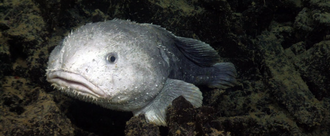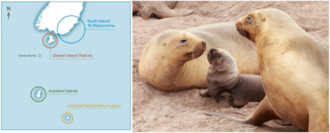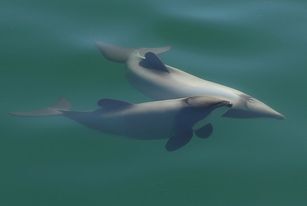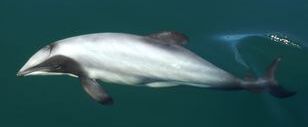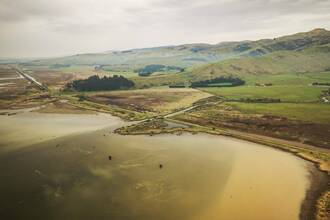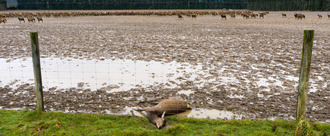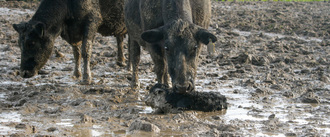-
Save the blobfish!We are standing at a critical moment in time when the deep sea is under increasing threat from human activities. The blobfish is a prime example of a species on the brink of extinction, not because of natural causes, but due to destructive practices like deep-sea trawling. It's essential to act now because if the blobfish, which was only recently discovered, is already at risk, other species we don't even know about may already be disappearing. The damage caused by deep-sea trawling is devastating and widespread, affecting entire ecosystems that take decades, if not centuries, to recover. Why do we need to join together now in a campaign for change? • Protect Biodiversity: The blobfish is just one species among many that are suffering due to our lack of protective measures for deep-sea environments. By acting now, we can safeguard the rich diversity of life that exists in the depths of the ocean. • Preserve Ecosystems: Once deep-sea habitats are destroyed, the damage is often irreversible. Protecting these environments now ensures future generations will benefit from healthy marine ecosystems. • Raise Global Awareness: A campaign like this helps raise awareness not only for the blobfish but for the broader issue of deep-sea conservation. The more people know, the more support we can build for long-term change. • Drive Policy Change: By uniting in this campaign, we can push for policy reforms that ban destructive fishing practices and enforce stricter regulations for deep-sea exploitation. Find out more about the blobfish!100 of 200 SignaturesCreated by Eden Li
-
Protect Hector's from the fishing industryNo dolphin should be drowned in a net. Yet since Christopher Luxon has been Prime Minister, at least 15 Hector's dolphins have been killed by the fishing industry. They include a mother and calf pair, juvenile dolphins and adults, with almost all of them around Canterbury. Māui and Hector's used to be the most abundant dolphins around NZ's coastal waters. Now they are among the world's rarest. PM Luxon must protect Hector's from the fishing industry. Be a Dolphin Defender and help stop extinction. Links Stuff Luxon office protestors say at least 15 Hector’s dolphins killed since he was PM The Press, Andrea Vance Dolphin protest targets PM Luxon’s office Stuff Fisheries Minister rejects dolphin protestors claims TV3 The Grim Reaper visits Botany from 4.34 Stuff poll Our wrap video Our Givealittle page3,308 of 4,000 SignaturesCreated by Christine Rose
-
Stop fishing industry sea lion deathsPakake, the New Zealand sea lion is the world’s rarest sea lion and an endangered species. There are only 10,000 and live around the remote subantarctic Auckland Islands. Acting on advice from the Ministry for Primary Industries, and against Department of Conservation advice, the new Minister for Fishing Shane Jones has removed a ‘mortality limit’ for sea lion deaths. This is the maximum number of deaths caused by commercial fishing. The number was set to protect the population, as more deaths would threaten the survival of the species. This is outrageous - pakake are at risk of going extinct, and we should be finding as many ways as possible to protect them. The number of sea lion pups dropped by almost a third last year. They could be affected by heating ocean temperatures, and commercial fishing depleting their food sources. The southern squid trawl fishery operates around the Auckland Islands and overlaps with the sea lion foraging grounds. Fishing vessels kill sea lions by accident as ‘bycatch’. The mortality limit was set at 52 deaths and was a red line for the fishery - if it went over the limit the fishery would be closed. This protected, endangered species needs protection, but the Minister of Oceans & Fisheries has decided to listen only to the voices of the commercial fishing industry! Sign our petition to reinstate the death limit, and support the call for more protection! *** https://www.thepost.co.nz/nz-news/350240291/death-limit-endangered-new-zealand-sea-lions-scrapped https://www.mpi.govt.nz/dmsdocument/38189-Squid-6T-Operational-Plan-2019-20231,547 of 2,000 SignaturesCreated by Emma Page
-
ECan Protect Hector's Dolphins through your Regional PlanUpokohue/ Hector's dolphins are one of the rarest marine dolphins in the world. Their greatest concentrations are found on the west and east coasts of the South Island and have the conservation status of ‘nationally vulnerable’. Hector's dolphins are threatened by many human activities. No dolphins should die as a result of fishing related practices. Yet fishing impacts have been devastating for the species. Dolphins continue to be killed in trawl nets. The rules around bycatch - and fishing near shore, are too weak. The fishing boat Austro Carina grounded recently off Banks Peninsula and is leaking oil, threatening wildlife (Oct 2023). It was legally fishing within endangered Hector's habitat, less than 2m from shore, which shows it's not just direct fishing risks that threaten Hector's habitat, but indirect fishing activities too. A small population of Hector’s lives in Lyttelton Harbour and is already threatened by industrial activities, noise and massive cruise ships. The competitive boat race SailGP also occurs in the dolphin habitat, and tourism also impacts on the dolphins. 🐬 Environment Canterbury can fix this, and it must. We call on ECan to protect Hector's from fishing related impacts through the Council's Regional Plan.4,735 of 5,000 SignaturesCreated by Christine Rose
-
Stop Fukushima radioactive waste water dump into the PacificJapan is preparing to dump about 1.3 million tonnes of contaminated water into the Pacific over the next three to four decades. It claims this would be made safe through an Advanced Liquid Processing System (ALPS) and then dilution, but the water will still be radioactive. The dump of contaminated water is part of the effort to decommission the Fukushima Daiichi Nuclear Power Plant, 12 years after it was overwhelmed by a tsunami. International laws are clear that States cannot undertake activities in their own waters that will have harmful effects in the high seas. There is no question that releasing radioactivity is contaminating the high seas. By not challenging the move, Pacific leaders, including New Zealand, could be undermining [1] the objectives of the South Pacific Nuclear Free Zone Treaty, otherwise known as the Rarotonga Treaty. Article Seven of the Rarotonga Treaty[2] places an obligation on states which are signatories to "prevent dumping" in light of the legacy of nuclear weapons testing in the region. Ocean currents experts are predicting the waste would sweep right across the Pacific. Nations in the Asia Pacific region, led by the Pacific Island Forum, have strongly voiced their opposition to the plans.[3] Some of the world’s leading oceanographic institutes and marine scientists have criticised the weakness of the scientific justification[4] applied by TEPCO, the owner of the nuclear plant, warned against using the Pacific Ocean as a dumping ground for radioactive contaminated water, and called for alternatives to discharge to be applied. Pacific Islands Forum (PIF) secretary general Henry Puna has said that the release poses major impacts and long-term worry for Pacific Island states who should not have to bear another nuclear testing activity. Greenpeace International says [5] “The Japanese government is desperate for international endorsement for its Pacific Ocean radioactive water dump plans. It has failed to protect its own citizens, including the vulnerable fishing communities of Fukushima, as well as nations across the wider Asia Pacific region. The aftermath of the nuclear disaster at Fukushima is still strongly felt, and the Japanese government has failed to fully investigate the effects of discharging multiple radionuclides on marine life. The government is obligated under international law to conduct a comprehensive environmental impact assessment, including the impact of transboundary marine pollution, but has failed to do so. Its plans are a violation of the UN Convention Law of the Sea.” Greenpeace East Asia analysis[6] has detailed the failures of liquid waste processing technology at the Fukushima Daiichi plant and the environmental threats posed by the releases. REFERENCES: Rarotonga Treaty could be 'undermined' if Pacific leaders don't oppose Japan's nuclear dump | RNZ News: https://www.rnz.co.nz/international/pacific-news/492863/rarotonga-treaty-could-be-undermined-if-pacific-leaders-don-t-oppose-japan-s-nuclear-dump Treaty of Rarotonga | NATIONS UNIES: https://www.un.org/nwfz/fr/content/treaty-rarotonga#:~:text=The%20Rarotonga%20Treaty%20also%20includes,radioactive%20matter%20(Article%207) Japan must work with the Pacific to find a solution to the Fukushima water release issue – otherwise we face disaster: https://www.forumsec.org/2023/02/06/op-ed-japan-must-work-with-the-pacific-to-find-a-solution-to-the-fukushima-water-release-issue-otherwise-we-face-disaster/ 2022-12 Position Paper: Release of Radioactively Contaminated Water into the Ocean: https://www.naml.org/policy/documents/2022-12-12%20Position%20Paper,%20Release%20of%20Radioactively%20Contaminated%20Water%20into%20the%20Ocean.pdf Ignoring science, environmental protection and international law – G7 endorses Japan’s Fukushima water discharge plans: https://www.greenpeace.org/international/press-release/59193/science-environmental-protection-international-law-g7-japans-fukushima-water-discharge/ Stemming the Tide 2020: The reality of the Fukushima radioactive water crisis: https://www.greenpeace.org/static/planet4-japan-stateless/2020/10/5e303093-greenpeace_stemmingthetide2020_fukushima_radioactive_water_crisis_en_final.pdf842 of 1,000 SignaturesCreated by Nick Young

-
Scuttle SailGP Lyttelton for Hector's DolphinsUpokohue/ Hector's dolphins are one of the rarest marine dolphins in the world. They are found mostly on the east coast of the South Island and have a conservation status of ‘nationally vulnerable’. Hector's dolphins are under many threats. A small population lives in Lyttelton Harbour and is already threatened by industrial activities, noise and massive cruise ships. SailGP is a high speed race where boats foil. It is like a Grand Prix racing car competition on water. The race course overlaps the area Hector's occupies. Hector's dolphins are at serious risk of boat strike injury or death. Lyttelton is a Hector's dolphin Marine Mammal Sanctuary and no place for a high speed race. We acknowledge the role of the Te Roopū Tiaki Whakaraupō Advisory Group in advocating for dolphin protection, and Ngāti Wheke's kaitiakitanga role. We believe the best protection for Hector's dolphins is to not hold the race in Lyttelton at all. Facts about Hector’s and Māui dolphin, Department of Conservation SailGP pulls controversial dolphin deterrent, Newsroom Comment: SailGP set to blast into Lyttelton, Northern Advocate1,308 of 2,000 SignaturesCreated by Christine Rose
-
A Moratorium on Fishing of Long Finned Eel (Tuna) Needs to Be Implemented Immediately"The greatness of a nation and its moral progress can be judged by the way its animals are treated." - Mahatma Gandhi “Any threat to the eels are a threat to the identity and mana of the iwi and hapū who have a responsibility to protect them… It is outrageous that people are still catching them for profit.” - Sir Pita Sharples, 2013 "The Government must suspend the commercial catch of New Zealand's longfin eel, and accept the conclusion by Parliament's environment watchdog that the eel is on a path to extinction" - Green Party spokesperson for conservation and oceans & fisheries., Eugenie Sage, 2016 https://www.greens.org.nz/govt-must-act-longfin-eels-disappear "Killing a kererū - which is classified as "Near Threatened" - is punishable with a $100,000 fine, and/or up to two years in prison. Yet with the long finned eel - which is classified as "Endangered" – not only can recreational fishers legally take up to 6 day, but killing them is rewarded with somewhere between $10 and $20 per eel on the export market" - Charlie Mitchell, Environment Correspondent, Stuff, 2019 "https://www.stuff.co.nz/environment/113450351/managed-to-extinction-are-we-at-risk-of-losing-our-creature-of-mystery "The concern among scientists is that freshwater eel numbers are declining to the point where populations will not possess the critical mass necessary to carry on migration and reproduction. In the 19th century, the North American population of passenger pigeons was estimated to be over six billion, representing 25 percent or more of the total avian biomass of the continent. Even though millions of passenger pigeons were being killed every year, it seemed the resource could never be exhausted. The species went extinct in 1914" -James Prosek, award winning author, artist and filmmaker, 2010 https://e360.yale.edu/features/a_steady_steep_decline_for_the_lowly_uncharismatic_eel "Tuna whakaheke deaths are disastrous for the future" - Hori Kingi, Ngā Kaitiāki o Ngā Wāimāori https://www.nzherald.co.nz/northern-advocate/news/eels-minced-by-hikurangi-swamp-pumps-dumped-at-council-offices/HIFOC2IWYHNGTM7ZV6E7MXFX4Y/ The long-finned eel (tuna) is endemic to New Zealand. It is an ancient species with a profound connection to our land and its people. It is an iconic and mythical species with an important place in the history and folklore of Māori - with a special traditional role as a spiritual protector of the land, nature and people - as much as the kiwi, kererū, tuatara, Hector's dolphin and the like. It is categorized by the Department of Conservation as "Declining - At Risk" and yet we are exporting as much as 100 tonnes of them per year as well as allowing recreational fishermen to fish them at will. The tuna is one of the largest eel species in the world. It was once very common in our waters; today, it is endangered, yet we continue to plunder it. The government has done little meaningful to protect the species, despite prior petitions being presented to them (in 2013). When in opposition, Labour and the Greens supported the proposal of this petition (a moratorium on commercial harvesting) yet when they were elected, little changed. The tuna is a noble, beautiful, mighty species of creature that deserves a place in the heart of every citizen, just as the kiwi and tuatara. They bring happiness to people when they can see and interact with them in the wild. At this rate, reserves like Ngā Manu will be the only place to see them, and eventually the species will be gone forever - exactly like what happened (almost) to the American bison and the passenger pigeon, both species which were annihilated from billions of individuals to extinction or near extinction by thoughtless greed in the space of a matter of decades. Surely we are better than that - I think most Kiwis would assume that we are, but our history, and current policies and attitudes with respect to this issue, puts those important values in serious question. The campaign acknowledges the kaitiaki status of mana whenua/local iwi to best look after tuna. Note that a member of the community representing Eel Activists Wairarapa has made a submission to parliament petitioning for the species of tuna to be granted absolute protection, in light of its endangered status. Please also consider signing this petition here https://www.parliament.nz/en/pb/petitions/document/PET_113510/petition-of-david-famularo-protect-the-longfin-eeltuna Join the eel conservation Facebook group here https://www.facebook.com/groups/472729636842389/ I believe placing the tuna on the protected species list, like the kiwi, kea, native lizards, native dolphins, and so on, is ultimately the most desirable outcome, but the most urgent step is to place at least a temporary halt on its utterly unsustainable commercial exploitation. https://e360.yale.edu/features/a_steady_steep_decline_for_the_lowly_uncharismatic_eel https://www.stuff.co.nz/environment/128521642/threatened-eels-still-being-harvested-for-food-renewing-call-for-commercial-fishing-ban https://www.stuff.co.nz/environment/113954064/the-dams-the-science-and-the-tiny-industry-clinging-to-life?rm=a https://www.stuff.co.nz/environment/82056650/pressure-to-ban-fishing-of-longfin-eels-rises-as-industry-faces-upheaval?rm=ahttps://www.stuff.co.nz/taranaki-daily-news/69946047/eels-just-as-worthy-of-protections-as-kereru https://www.longfineel.co.nz/wp-content/uploads/2011/06/Tuna-Kuwharuwharu-Longfin-Eel.pdf https://eel-activists-wairarapa.blogspot.com/ https://www.pce.parliament.nz/publications/on-a-pathway-to-extinction-an-investigation-into-the-status-and-management-of-the-longfin-eel http://www.longfineel.co.nz/extinction-crisis/ https://www.visitzealandia.com/Events/ArtMID/2271/ArticleID/272/Tunaeel-release-to-keep-population-thriving http://www.longfineel.co.nz/conservation/ https://www.doc.govt.nz/nature/native-animals/freshwater-fish/eels/596 of 600 SignaturesCreated by Liam McMahon
-
Stop the proposed cattle feedlots in Te Waihora (Lake Ellesmere) - Ōtautahi★ 16 June 2022: The Little River ECO-Collective gathered in front of ECAN, the head offices of Environment Canterbury in Christchurch, to present the 2 petitions huge 2000-cattle feed barn with well over 3000 signatures. Green MP Eugenie Sage and Labour MP Tracey McLellan will attend the event in support. Please continue to help build the pressure to put this issue on the agenda. Write to ECAN to express your concern about the lack of appropriate action – ask ECan to make the Wongan Hills feedlot application ‘publicly notifiable’, and involve us in the decision making: email Chief Executive of ECan: [email protected] ★ Te Waihora (Lake Ellesmere) is the largest lake in Canterbury/Waitaha and one of the most important wetland habitats in New Zealand, providing homes for numerous birds, plants and invertebrates. Yet it’s also heavily polluted from the runoff of surrounding farms with some of the country’s highest concentrations of sediment, nitrogen and phosphorus. Over-allocation of water to irrigation schemes contributes to the problem. It could get much worse with a proposal for industrial farms and thousands of cattle right on its shores. Christchurch City Council has granted consent for company Wongan Hills to build two 200m-long indoor barns, or feedlots, holding up to 1000 steers each, raised for beef, in Kaituna Valley, Banks Peninsula. The sheds breach several district plan rules, including those for maximum building footprint which is meant to be 300m². The barns and buildings will cover 24,330m². These proposed feedlots to be installed on Te Waihora land are utterly unacceptable. The lake already suffers enormously from pollution from current farming practices. Feedlots are a style of intensive indoor farming that is focused on increased production from animals, in larger numbers, in smaller spaces. Feedlots risk spreading disease and the huge amounts of waste pollute waterways, soil and plant life. Animal farming is responsible for a large part of New Zealand’s greenhouse gas emissions and these intensive feedlots do not align with the way Aotearoa should be responding to the current climate crisis. This kind of intensive farming has no place in Aotearoa, and especially Canterbury. We should be moving to regenerative and organic agricultural systems that work with the environment, not against it. We strongly oppose this and call on the Council to throw it out immediately. There should be no chance of a consent from Environment Canterbury. [Image: Stuff] Controversial farmer’s next venture: A feedlot https://www.newsroom.co.nz/pro/controversial-farmers-next-venture-a-feedlot Whakaora Te Waihora https://ngaitahu.iwi.nz/environment/te-waihora/whakaora-te-waihora/ Land, air, water Aotearoa - Te Waihora/Lake Ellesmere water quality https://www.lawa.org.nz/explore-data/canterbury-region/lakes/te-waihoralake-ellesmere/#:~:text=Average%20water%20quality.,Mesotrophic%20lake%20conditions. How to fix Te Waihora/Lake Ellesmere https://www.nzgeo.com/stories/how-to-fix-te-waihora-lake-ellesmere/ Why you should give a damn about feedlots https://thespinoff.co.nz/food/23-08-2018/why-you-should-give-a-damn-about-feedlots2,086 of 3,000 SignaturesCreated by Annelies Pekelharing
-
Give cows a life worth livingThere are over six million dairy cows in New Zealand. They are literally everywhere across our landscape as farming has intensified. A more sustainable future that is kinder for cows and truly gives them a good life, a life worth living, must include a transition to more plant-based regenerative agriculture, and that's better for the planet too. Our animal welfare laws establish animal sentience as a basis for how we treat farmed animals.(1) This means we recognise cows feel pain. They think, have physical and social wants and needs, including food, water and shelter, and the company of (cow) friends and family, just like us. They are peaceful, generous herbivores but we’re exploiting them for profit. Our laws also recognise the need for 'a good life for cows' as a basic measure of welfare. This means they must have food and shelter. But they also need, and deserve, 'a life worth living' - with friendship, enrichment – a variety and things of interest, and ‘positive affective states’ - happiness, too.(2) Yet dairy cows have anything but a good life and a life worth living.(3) Since the 1990s the dairy industry has squeezed cows more closely together for higher production. Cows are exposed to the harsh weather because shelterbelts were removed to fit in more cows. Intensive winter grazing can see cows crammed in at two per metre (!) and forced to sleep and give birth in mud.(4) All calves are taken from their mothers at around four days old, and around two million of them are killed outright either at the slaughterhouse or on-farm. At least a quarter of the herd is also 'replaced' - killed, every year. And that's mostly for milk, butter and other dairy products, 96% of which get sent overseas. We make so much money from cows in Aotearoa, we're living on the cows' back. The least we can do is ensure they have lives worth living in this Code of Welfare review. Ultimately, cows deserve to live in a world in intact family units where they are not exploited and killed for their bodily products. We have the power to shape a genuinely good life for cows and ensure they have a life worth living, in the 2022 Government review of the dairy cow Code of Welfare. Let’s do it. [1] Animal sentience: https://www.mpi.govt.nz/animals/animal-welfare/national-animal-welfare-advisory-committee/animal-sentience-their-emotions-feelings-and-experiences-of-life/ (2) https://www.ncbi.nlm.nih.gov/pmc/articles/PMC4810049/ (3) https://www.stuff.co.nz/business/farming/125319128/animal-welfare-complaints-increasing-in-dairy-industry (4) https://www.mpi.govt.nz/dmsdocument/38210/direct375 of 400 SignaturesCreated by Christine Rose
-
Stop Intensive Winter Grazing: Get animals out of mud on our Pāmu farms and save our riversPāmu (AKA Landcorp Farms) belongs to all New Zealanders and we, the public, are all stakeholders with a right to say what is done on our behalf. Intensive Winter Grazing (IWG) is cruel to animals, it’s polluting our rivers, streams, estuaries and groundwater, and it is damaging the reputation of Aotearoa New Zealand. The practice of confining large numbers of animals into a small area over winter churns paddocks to a deep slurry of mud, faeces and urine. The toxic runoff pollutes our waterways and kills freshwater life in rivers and estuaries. As well as pollution, there are serious animal welfare problems associated with the practice as this recently released graphic footage of cows being forced to give birth in the freezing mud shows. There are better ways to farm. Pāmu should lead by example, end intensive winter grazing and shift to less intensive land use. Pāmu can do this and still make money - their own modelling proves it. This practice is very stressful on individual Pāmu farm managers and staff. Taking the pressure off them will improve wellbeing and mental health. More Information: Freshwater pollution: Nitrate leaches into our aquifers at up to 10 times the rate of normal grazing, destroying groundwater for future use and remaining for hundreds of years. Phosphate and pathogen-rich effluent runs off into streams, rivers, lakes and estuaries, making them unswimmable, and killing ecosystems. Animal suffering: When it rains the land on which these animals are grazed turns to mud, leaving heavily pregnant mothers with nowhere dry to rest and give birth. They get exhausted and end up drinking muddy water to hydrate. Dry paddocks are often full of boulders which are painful to stand on. Soil degradation and loss: IWG destroys the soil and releases tonnes of stored carbon into the atmosphere, accelerating climate breakdown. It’s practice is heavily dependent on pesticides, herbicides and synthetic fertilisers which are causing severe decline in biodiversity and human health. It’s also the cause of huge loss of valuable topsoil. #EndIntensiveWinterGrazing1,179 of 2,000 SignaturesCreated by Geoff Reid

-
End all NZ Super Fund Investments in Intensive Winter GrazingOur nation’s global reputation relies on a government that puts the health of its environment and people's wellbeing first. Spending millions of dollars from the nation’s pension fund on farms that practice Intensive Winter Grazing is one of the most unethical choices the Superannuation investment fund has EVER made! In contrast to traditional grazing, Intensive Winter Grazing restricts animals to small patches of land for long periods, which quickly turn into mud. This practice causes freshwater pollution, animal suffering and soil degradation. Freshwater pollution: Nitrate leaches into our aquifers at over 10 times the rate of normal grazing, destroying groundwater for future use and remaining for hundreds of years. Phosphate- and pathogen-rich effluent runs off into streams, rivers, lakes and estuaries, making them un-swimmable, and killing ecosystems. Animal suffering: The land these animals are grazed on turns to mud, which leaves animals with nowhere dry to rest and give birth. They often end up licking mud to get water. Soil degradation: Intensive Winter Grazing destroys the soil and releases tonnes of stored carbon into the atmosphere, accelerating climate breakdown. This practice is heavily dependant on pesticides, herbicides and synthetic fertilisers which are causing severe decline in biodiversity and human health. This is no way to be ‘investing for the next generation’. Please sign and share this petition with your networks Email the minister responsible: Hon Grant Robertson, Minister of Finance. [email protected] Tell him to; Stop investing any of the New Zealand Super Fund into farms that are winter crop grazing, divest from any that continue, and find sustainable alternatives immediately! #EndIntensiveWinterGrazing7,452 of 8,000 SignaturesCreated by Geoff Reid


